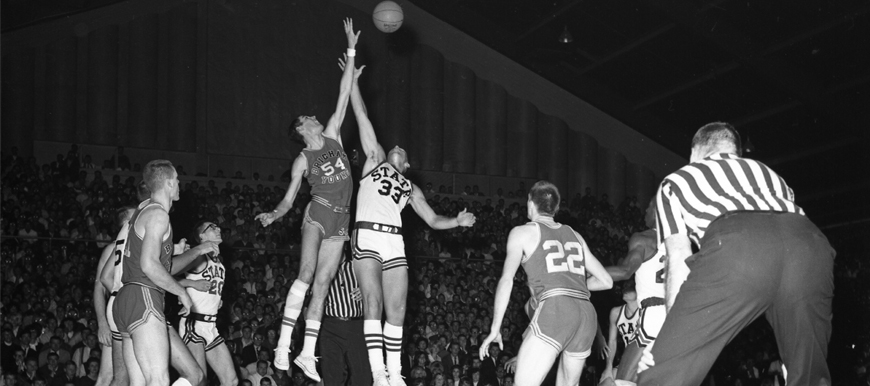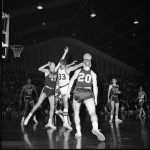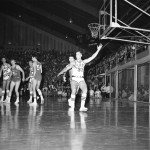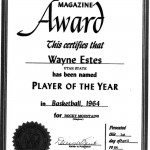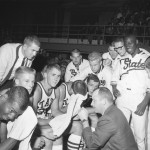The Great One
“Wayne Estes is dead, and Utah State will never be the same because of it.” — The Utah Statesman, Feb. 10, 1965
On Feb. 8, 1965, Utah State’s All-American basketball player Wayne Estes tragically died 19 games into his senior season.
Estes was electrocuted in Logan while exploring the scene of a car crash on the same night he scored 48 points in a game against Denver — four points below his career-high of 52 set earlier that season. A downed power line grazed the top of the 6-foot-6-inch Estes’s head, sending electricity jolting through his body.
“This generation of Aggies will never forget Wayne Estes,” said Dr. Daryl Chase after his death. Chase was the 10th president of Utah State University and held the position from 1954 through 1969.
“He was the handsome youth in our midst who taught us all dedication to our sciences, arts and our crafts. He taught us lessons in humility in times of victory,” he said.
While that fateful night 50 years ago ended Estes’ life, his legacy and impact at the university continues to be felt to this day.
As a basketball player, they simply didn’t come any better.
Originally recruited from Anaconda, Montana to be a track and field athlete, Estes asked the coaches if he would be allowed to try out for the basketball team. When the coaches saw him play, he received a scholarship offer for basketball and never looked back.
The switch from track and field proved to be a great decision for Estes.
“He was outstanding from the beginning,” said Alan Parrish, a center on the 1965 team and the first player to meet Estes in Logan. “He was a great talent. As a player he was never selfish. He was always as interested in your success as he was his own. He was the ideal teammate. He was a leader by nature. If he had a good game, you usually won, and he didn’t have many bad ones.”
After playing on the freshman squad his first season, as was required at the time, he averaged 20 points per game as a sophomore while shooting 47 percent from the floor and 84 percent from the free throw line. He also grabbed nine rebounds per game.
Estes’ junior season in 1963-64 brought more of the same — only better. He shot the same percentage, upped his rebounds to 13 per game and averaged 28 points.
“Wayne was a superstar,” said LeRoy Walker, a senior small forward on the 1965 team. “Everyone loved him. He was never a selfish guy. He didn’t have an ego, and he didn’t have an agenda when he played.”
Saving the best for last, in the 19 games he played as a senior Estes scored nearly 34 points per game — a record for points per game in a season that he still holds at Utah State. He averaged 14 rebounds in each contest and hit on 87 percent of his free throws while going 49 percent from the field.
Rival coaches always spoke of him with high praise.
Compiled in the February 10, 1965 issue of the Statesman, Bob Cousy of Boston College, Stan Watts of BYU, Fred Taylor from Ohio State and Jim Williams from Colorado State all described him as the best shooter they had ever seen.
Estes hit the 2,000 point mark on the last shot of his career. He became the 18th player in NCAA history to hit 2,000 points and is still the third-leading scorer in Utah State history with 2,001 points. What makes the scoring even more impressive is that Estes did it without the 3-point shot.
Parrish said that if the 3-pointer was part of the game at that time, Estes would have averaged more than 40 points per game his senior season.
Estes, who wore jersey number 33, holds school records for the following categories: career points per game (26.7), free throws made in a career (469), consecutive double-digit games (64), points in a season (821), most points in a game (52) and most rebounds in a game (28).
He was named a consensus All-American in 1965 by the Associated Press and finished with the third-highest amount of votes in the nation, according to Bob Myers, the AP Bureau Chief in Salt Lake City at the time. Myers also noted that 90 percent of the ballots had been submitted before Estes’ death, meaning he wasn’t just put on the team because of the tragedy. He earned it.
“He had a huge impact,” said Hal Hale, a point guard who roomed with Estes on road trips. “He didn’t jump extremely high, but he had such a large body. He was like an aircraft carrier inside. He would take over, rebound and put shots back in. He also had tremendous touch on the ball. He had a real nice swinging-hook shoot, a smooth jump shot and just a feathery touch on the ball.”
For everything that Estes accomplished on the basketball court, he is best remembered by friends and teammates for the person he was off the court.
“He had a contagious glue of people wanting to be around him,” Walker said. “He drew people to him. Everyone could see Wayne as a big-hearted guy. You’ll never forget that smile Wayne Estes had. He was free.”
Eleanor Olson, one of Estes’ classmates and a friend to him off the court, said there is much to learn from him. She saw every home game he played in except for one. She says Estes’ made everyone around him a better person.
“He was a much better person than he was a basketball player, and he was an excellent basketball player,” Olson said. “I was too shy to get him to sign a program, so I had a friend do it for me. He said he wanted to meet me in person. After that he always said, ‘Hi,’ to me and called me by name.”
Frank Williams, USU’s athletic director at the time of Estes’ death, said although he achieved All-American status and the ability to be a great scorer, most of all he was an exemplary individual.
“Warm hearted, gracious, full of love for everyone, and everyone loved him,” Williams said of Estes after the accident.
First-year head coach LaDell Andersen had high praise for Estes, most of which was unrelated to basketball. Andersen wrote a eulogy that was printed in the 1965 edition of The Utah Statesman.
“You’ll never meet a more polite boy than Wayne,” Andersen wrote. “No one could have had a bigger heart. He never had anything but good things to say about anyone, regardless of race, creed or color.”
Whether it was a teammate, a friend or someone he didn’t know, Estes left the same type of impact on everyone at Utah State. His personality is one of the main reasons his legacy lives on at USU.
“He was, in his day, the ideal ball player,” Parrish said. “He was an outstanding student, a great family boy and a friend to everybody. I don’t think he ever realized how great he was out on the court. Number one, he was a really good friend. All around, as a person, he was just a regular guy.”
Fast forward 49 years. On May 14, 2014 the Wayne Estes Center was opened at Utah State University. The building is a 32,000-square-foot basketball practice facility and volleyball venue. The name for the center was chosen by Jim Laub, one of the main donors for the facility, who was a teenager in Cache Valley during Estes’ playing days.
During the ribbon-cutting ceremony for the building, Laub described Estes as the epitome of a positive role model. He also said the exhibit would ensure that all present and future generations of Aggie fans would never forget Estes’ contributions to Utah State.
Current USU athletic director Scott Barnes said Estes had an unbelievable future ahead of him that was taken away, but the person he was will always be remembered.
“His legacy has been celebrated because of his impact,” Barnes said. “First and foremost, he was a remarkable human being. He was a great person. Secondly, he was a great athlete. We have tried to remember him here on campus.”
Though Estes’ death will always be remembered as a tragic loss, the mark he made in life is forever embroidered in the tapestry of Utah State University and stands as a legacy for all of those that have followed.
Estes’ friends, teammates and admirers want that legacy to be remembered.
“The great Wayne Estes was here and gone,” Walker said. “He was one of a kind, like the Mona Lisa. You never forget greatness. The average guy you’ll forget, but you’ll never forget the great Wayne Estes.”
— kalen.s.taylor@gmail.com
Twitter: @kalen_taylor

